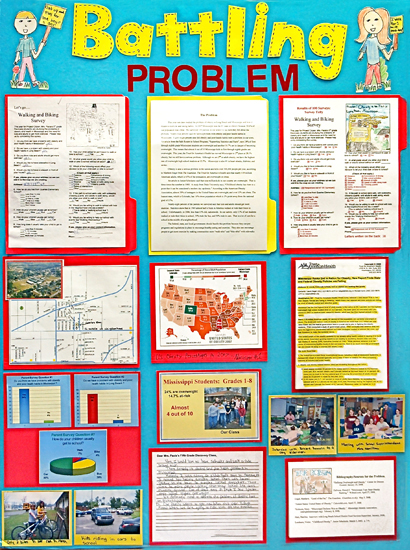Panel One: Problem

| Teacher Tips (click tip for explanation)
Subtitles SummaryIt helps if each panel is labeled with the subtitles to designate "The Problem," "Alternatives," "Our Policy," and "Plan of Action."
Summary Panel HintThe completed worksheets, "Explaining the Problem," from student text (pp 29-30) may be used by the "Problem Team" to compile a two-page, double-spaced summary of the information. The students will address all questions on the worksheets in their written summary. These two pages can be mounted separately or layered on the panel.
Panel Hint Matting of Display ItemsPrint all items on cardstock, especially if they are to be mounted in layers. Use transparent tape at the top to serve as a hinge.
Matting of Display Items Survey/QuestionnaireMounting your display items on fadeless colored paper adds color to your panels. Hint: Colored folders are sturdy and the perfect size for matting 8 ½ x 11 inch sheets of paper or cardstock.
Survey/Questionnaire Summary of Survey ResultsOnce the problem has been selected, guide students in developing a survey to gather data for their project. The results of the survey can be used in graphs and charts. Determine the groups to be surveyed and include a place on the survey for respondents to mark the group to which they belong. Be sure to include the questions "Do you think _______________ is a problem?" and "What would be the best way to solve the problem?"
Summary of Survey Results News ClippingsYour students will enjoy tallying the data from the surveys. Using an LCD/DLP projector, show your students how to create a table or chart to report the results.
News Clippings Research ArticlesInclude news articles or publications related to the problem. Be sure to include a caption or title for the article, including a citation of the source material, and highlight the most important information. Larger articles should include only the most relevant information. Include the entire article in the documentation binder.
Research Articles GraphicsThese should be limited to that information considered most important to document the problem. Short summaries should be used with the most important information highlighted. The full report can be placed in the documentation binder.
Graphics Letters of SupportGraphics that present pertinent information are excellent additions to the panels.
Letters of Support Map or Aerial ViewInclude letters of support from community members describing their views on the problem.
Map or Aerial View PhotographsIf appropriate to the problem, a map or aerial view of the geographic area affected by the problem should go on this panel. A title or caption is required.
Photographs Photography HintAll photos on this panel must be related to "The Problem" and include a caption to describe what is documented in the picture. You may include photos of individuals being interviewed, students conducting research in the field, or other events that document the problem being studied.
Photography Hint Graphs and Charts1. One or more students may be appointed as "official photographer" and be responsible for photographic documentation. 2. All photos may be posted on a computer in a photo gallery for teams to review and print as needed.
Graphs and Charts Bibliography or List of SourcesShow the students how to create graphs and charts using Excel or other computer programs. Then turn them loose with the data to create the graphs. Hint: You may have to limit their creative use of wild and crazy colors.
Bibliography or List of Sources
All sources of information used for this section of the project should be cited. This may be in the form of a formal bibliography or in an informal list of sources. Hint: Each team could appoint a member to be the "bibliography manager" whose responsibility it would be to gather the reference information and compile the bibliography for that section of the portfolio. |